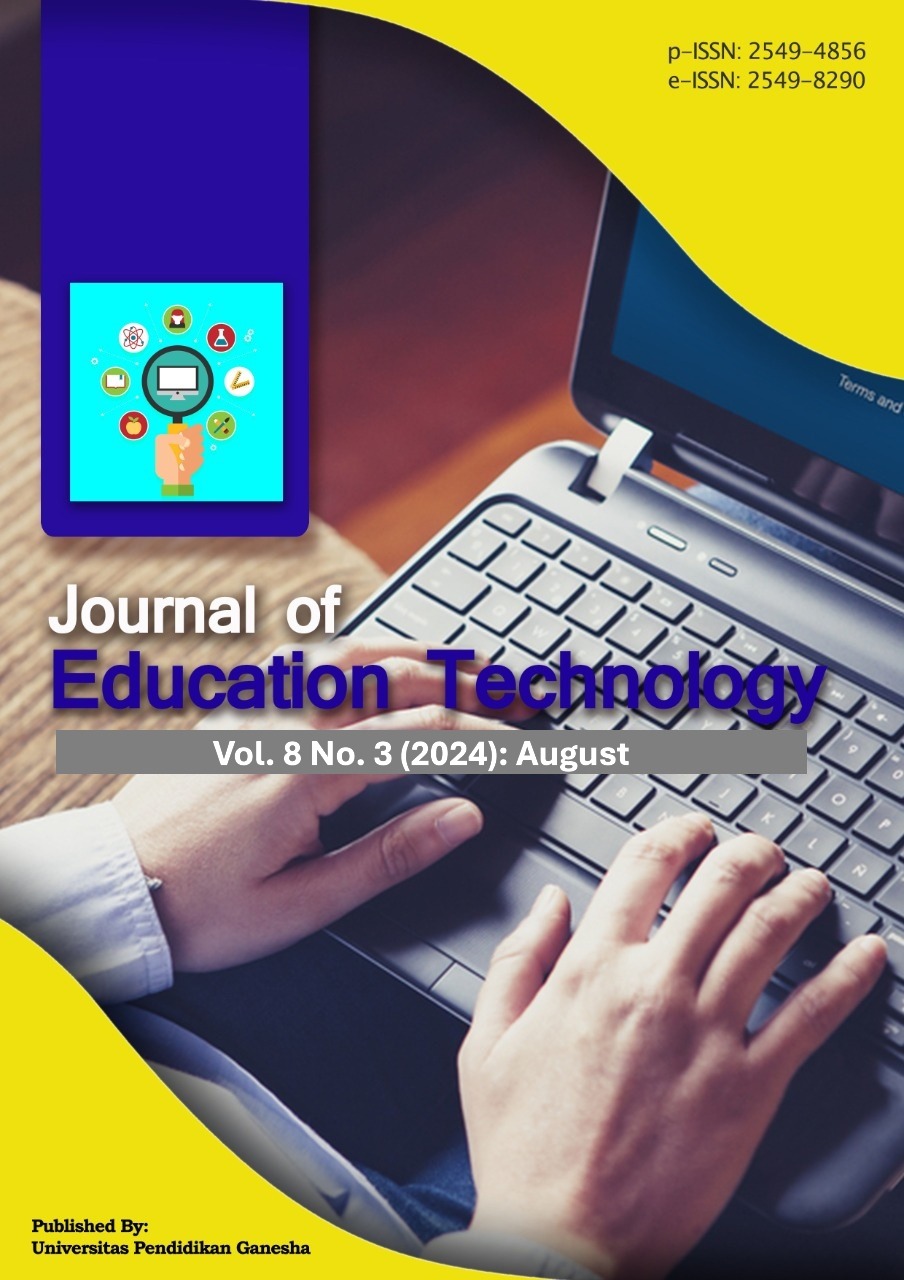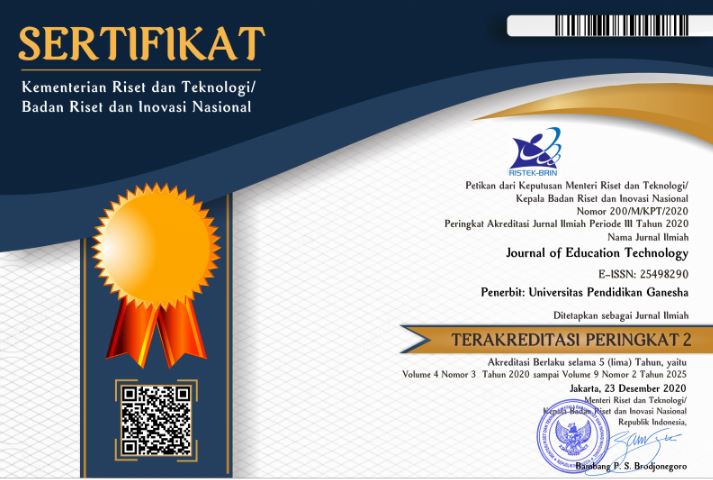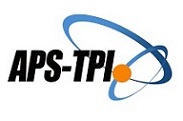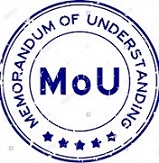Modelling the Transformation of Agricultural Program Teaching and Learning into Technology Integration
DOI:
https://doi.org/10.23887/jet.v8i3.76898Keywords:
Agricultural Program, Technology Integration, TransformationAbstract
The world is currently experiencing transformation in most areas, including in education. The teaching and learning of agricultural programmes ought to be modelled and aligned with transformation. The shift from traditional classroom teaching and learning requires support to train agriculture with technology integration. Therefore, the aim of this study is to analyze the transformation of the teaching and learning of agricultural programmes using technology. This study utilised a qualitative research method. There were 20 lecturers from three Technical and Vocational Education and Training (TVET) college campuses that were involved in this study. The findings revealed that transforming agricultural programmes to fully integrate technology is hampered by a lack of resources, equipment, and infrastructure. Teaching and learning support with resources and tools to acclimate to learning agriculture with technology integration is required. The study underscored the need for and the importance of providing support to institutions that are struggling to acquire teaching and learning resources, equipment, and infrastructure to implement the integration of technology. These findings emphasise the need to provide support for technical resources, equipment, and infrastructure to enhance the integration of technology. The research findings led to the development of a conceptual model for technology integration in TVET agricultural education. The key interrelated features that can be used to improve the support of technology integration in TVET colleges are clearly stipulated in the model.
References
Al-alawi, A. I., & Elias, H. (2022). Digital transformation adoption in human resources management during COVID-19. https://doi.org/10.1108/AGJSR-05-2022-0069.
Alemdag, E., Cevikbas, S. G., & Baran, E. (2020). Studies in Continuing Education The design, implementation, and evaluation of a professional development programme to support teachers’ technology integration in a public education centre. https://doi.org/10.1080/0158037X.2019.1566119.
Alenezi, M., Wardat, S., & Akour, M. (2023). The Need of Integrating Digital Education in Higher Education: Challenges and Opportunities (pp. 1–12). https://doi.org/10.3390/su15064782.
Ari, R., Altinay, Z., Altinay, F., Dagli, G., & Ari, E. (2022). Sustainable Management and Policies: The Roles of Stakeholders in the Practice of Inclusive Education in Digital Transformation. Electronics (Switzerland, 11(4), 1–16. https://doi.org/10.3390/electronics11040585.
Ashaye, O. R., & Irani, Z. (2019). The role of stakeholders in the effective use of e-government resources in public services. International Journal of Information Management, 49(January), 253–270. https://doi.org/10.1016/j.ijinfomgt.2019.05.016.
Asuman, B., Khan, M. S. H., & Clement, C. K. (2018). Integration of web-based learning into higher education institutions in Uganda: Teachers’ perspectives. International Journal of Web-Based Learning and Teaching Technologies, 13(3), 33–50. https://doi.org/10.4018/IJWLTT.2018070103.
Baidoo-anu, D., & Ansah, L. O. (2023). Education in the Era of Generative Artificial Intelligence (AI): Understanding the Potential Benefits of ChatGPT. Promoting Teaching and Learning, 7(December), 52–62. https://doi.org/10.2139/ssrn.4337484.
Barakabitze, A. A., William-Andey Lazaro, A., Ainea, N., Mkwizu, M. H., Maziku, H., Matofali, A. X., Iddi, A., & Sanga, C. (2019). Transforming African Education Systems in Science, Technology, Engineering, and Mathematics (STEM) Using ICTs: Challenges and Opportunities. Education Research International. https://doi.org/10.1155/2019/6946809.
Bin, E., Islam, A. Y. M. A., Gu, X., Spector, J. M., & Wang, F. L. (2020). A study of Chinese technical and vocational college teachers’ adoption and gratification in new technologies. British Journal of Educational Technology, 51(6), 2359–2375. https://doi.org/10.1111/bjet.12915.
Bonfield, C. A., Salter, M., Longmuir, A., Benson, M., & Adachi, C. (2020). Transformation or evolution? Education 4.0, teaching and learning in the digital age. Higher Education Pedagogies, 5(1), 223–246. https://doi.org/10.1080/23752696.2020.1816847.
Bonnes, C., & Hochholdinger, S. (2020). Approaches to Teaching in Professional Training: A Qualitative Study. Vocations and Learning, 13(3), 459–477. https://doi.org/10.1007/s12186-020-09244-2.
Bosica, J., Pyper, J. S., & MacGregor, S. (2021). Incorporating problem-based learning in a secondary school mathematics preservice teacher education course. Teaching and Teacher Education, 102, 103335. https://doi.org/10.1016/j.tate.2021.103335.
Boursianis, A. D., Papadopoulou, M. S., Diamantoulakis, P., Liopa-Tsakalidi, A., Barouchas, P., Salahas, G., Karagiannidis, G., Wan, S., & Goudos, S. K. (2022). Internet of Things (IoT) and Agricultural Unmanned Aerial Vehicles (UAVs) in smart farming: A comprehensive review. In Internet of Things (Netherlands (Vol. 18, p. 100187). https://doi.org/10.1016/j.iot.2020.100187.
Braun, V., Clarke, V., Boulton, E., Davey, L., & McEvoy, C. (2021). The online survey as a qualitative research tool. International Journal of Social Research Methodology, 24(6), 641–654. https://doi.org/10.1080/13645579.2020.1805550.
Brick, K., Cooper, J. L., Mason, L., Faeflen, S., Monmia, J., & Dubinsky, J. M. (2021). Training-of-Trainers Neuroscience and Mental Health Teacher Education in Liberia Improves Self-Reported Support for Students. Frontiers in Human Neuroscience, 15(June), 1–15. https://doi.org/10.3389/fnhum.2021.653069.
Daouk, L., & Aldalaien, M. (2019). The Usage of E-Learning Instructional Technologies in Higher Education Institutions in the United Arab Emirates (UAE. Turkish Online Journal of Educational Technology - TOJET, 18(3), 97–109. https://eric.ed.gov/?id=EJ1223782.
Daqar, M. A., & Constantinovits, M. (2021). The Impact of Training on Banks Employee Performance. Hungarian Agricultural Engineering, 39. https://doi.org/10.17676/HAE.2021.39.22.
Dede, C., Ketelhut, D. J., Whitehouse, P., Breit, L., & McCloskey, E. M. (2009). A research agenda for online teacher professional development. Journal of Teacher Education, 60(1), 8–19. https://doi.org/10.1177/0022487108327554.
Deroncele-Acosta, A., Palacios-Núñez, M. L., & Toribio-López, A. (2023). Digital Transformation and Technological Innovation on Higher Education Post-COVID-19. Sustainability (Switzerland, 15(3). https://doi.org/10.3390/su15032466.
Desai, Z., & Nomlomo, V. (2014). Reflections on the development of a pre-service language curriculum for the BEd (Foundation Phase). South African Journal of Childhood Education, 4(3), 15. https://doi.org/10.4102/sajce.v4i3.227.
Dlamini, R. S. (2015). The role of the strategic and adaptive Chief Information Officer in higher education. Education and Information Technologies, 20(1), 113–140. https://doi.org/10.1007/s10639-013-9269-5.
Engelbrecht, J., Llinares, S., & Borba, M. C. (2020). Transformation of the mathematics classroom with the internet. ZDM - Mathematics Education, 52(5), 825–841. https://doi.org/10.1007/s11858-020-01176-4.
Ertmer, P. A., Ottenbreit-leftwich, A. T., Sadik, O., Sendurur, E., & Sendurur, P. (2012). Computers & Education Teacher beliefs and technology integration practices: A critical relationship. Computers & Education, 59(2), 423–435. https://doi.org/10.1016/j.compedu.2012.02.001.
Gebresenbet, G., Bosona, T., Patterson, D., Persson, H., Fischer, B., Mandaluniz, N., Chirici, G., Zacepins, A., Komasilovs, V., Pitulac, T., & Nasirahmadi, A. (2023). Smart Agricultural Technology A concept for application of integrated digital technologies to enhance future smart agricultural systems. Smart Agricultural Technology, 5(May), 100255. https://doi.org/10.1016/j.atech.2023.100255.
George, B. (2023). Administrative sciences Managing the Strategic Transformation of Higher Education through Artificial Intelligence. https://doi.org/10.3390/admsci13090196.
Gkrimpizi, T., Peristeras, V., & Magnisalis, I. (2023). Education sciences Classification of Barriers to Digital Transformation in Higher Education Institutions. Systematic Literature Review. https://doi.org/10.3390/educsci13070746.
Gunn, C. (2010). Sustainability factors for e-learning initiatives. ALT-J: Research in Learning Technology, 18(2), 89–103. https://doi.org/10.1080/09687769.2010.492848.
Haleem, A., Javaid, M., & Singh, R. P. (2024). Perspective of Leadership 4.0 in the Era of Fourth Industrial Revolution: A Comprehensive View. Journal of Industrial Safety, 100006. https://doi.org/10.1016/j.jinse.2024.100006.
Hamzah, S. N., Amin, F., Yunus, N., Razali, N., Rahim, M. B., Anuar, K., & Rahman, A. (2022). Development of an Educational Video of Air Conditioning Workshop Practice using the YouTube Platform. Research and Innovation in Technical and Vocational Education and Training, 2(2), 269–281. https://doi.org/https://doi.org/10.30880/ritvet.2022.02.02.030.
Harris, S. P., Davies, R. S., Christensen, S. S., Hanks, J., & Bowles, B. (2019). Teacher attrition: Differences in stakeholder perceptions of teacher work conditions. Education Sciences, 9(4). https://doi.org/10.3390/educsci9040300.
Inagaki, T. K., & Orehek, E. (2017). On the Benefits of Giving Social Support: When, why, and How Support Providers Gain by Caring for Others. Current Directions in Psychological Science, 26(2), 109–113. https://doi.org/10.1177/0963721416686212.
Jamshed, S. (2014). Qualitative research method-interviewing and observation. Journal of Basic and Clinical Pharmacy, 5(4), 87. https://doi.org/10.4103/0976-0105.141942.
Journeault, M., Perron, A., & Vallières, L. (2021). The collaborative roles of stakeholders in supporting the adoption of sustainability in SMEs. Journal of Environmental Management, 287(March). https://doi.org/10.1016/j.jenvman.2021.112349.
Kalugina, O. A., & Tarasevich, N. A. (2018). Smart technology integration into EFL teaching at the non-linguistic higher school. XLinguae, 11(1), 8–18. https://doi.org/10.18355/XL.2018.11.01XL.02.
Khan, N., Ray, R. L., Sargani, G. R., Ihtisham, M., Khayyam, M., & Ismail, S. (2021). Current progress and future prospects of agriculture technology: Gateway to sustainable agriculture. Sustainability (Switzerland, 13(9), 1–31. https://doi.org/10.3390/su13094883.
Kotrlik, J. W., Redmann, D. H., & Douglas, B. B. (2003). Technology Integration by Agriscience Teachers in The Teaching/Learning Process. Journal of Agricultural Education, 44(3), 78–90. https://doi.org/10.5032/jae.2003.03078.
Li, H., Khattak, S. I., Lu, X., & Khan, A. (2023). Greening the way forward: A qualitative assessment of green technology integration and prospects in a Chinese technical and vocational institute. Sustainability, 15(6), 1–16. https://doi.org/10.3390/su15065187.
Lomos, C., Luyten, J. W. H., & Tieck, S. (2023). Implementing ICT in classroom practice: what else matters besides the ICT infrastructure? Large-Scale Assessments in Education, 1–28. https://doi.org/10.1186/s40536-022-00144-6.
Masdoki, M., Din, R., & Effendi Ewan Mohd Matore, M. (2021). Teaching 4.0 competency in higher learning institutions: A systematic mapping review. International Journal of Learning, Teaching and Educational Research, 20(10), 217–231. https://doi.org/10.26803/ijlter.20.10.12.
McKnight, K., O’Malley, K., Ruzic, R., Horsley, M. K., Franey, J. J., & Bassett, K. (2016). Teaching in a digital age: How educators use technology to improve student learning. Journal of Research on Technology in Education, 48(3), 194–211. https://doi.org/10.1080/15391523.2016.1175856.
Misbah, Z., Gulikers, J., Dharma, S., & Mulder, M. (2020). Evaluating competence-based vocational education in Indonesia. Journal of Vocational Education and Training, 72(4), 488–515. https://doi.org/10.1080/13636820.2019.1635634.
Murphrey, T. P., Miller, K. A., & Roberts, T. G. (2009). Agricultural Science and Technology Teachers’ Perceptions of iPod and MP3 Technology Integration into Curricular and Cocurricular Activities. Journal of Agricultural Education, 50(4), 110–119. https://doi.org/10.5032/jae.2009.04110.
Nnodim, A. U., & W.I, R. (2023). Agricultural Technology Transfer Methods and Adaptability of Rural Farmers in Ikwerre Local Government Area of Rivers State. East Asian Journal of Multidisciplinary Research, 2(6), 2591–2604. https://doi.org/10.55927/eajmr.v2i6.4238.
Nungu, L., Mukama, E., & Nsabayezu, E. (2023). Online collaborative learning and cognitive presence in mathematics and science education. Case study of university of Rwanda, college of education. Education and Information Technologies. https://doi.org/10.1007/s10639-023-11607-w.
Odaral, S., Khanl, Z., & Ustun, T. S. (2015). Integration of Precision Agriculture and SmartGrid technologies for Sustainable Development (pp. 84–89). https://doi.org/10.1109/TIAR.2015.7358536.
Peng, R., Razak, R. A., & Halili, S. H. (2023). Factors influencing in-service teachers’ technology integration model: Innovative strategies for educational technology. PLoS ONE, 18(8 August), 1–19. https://doi.org/10.1371/journal.pone.0286112.
Ramli, S., Rasul, M. S., & Affandi, H. M. (2020). Identifying technology competency of green skills in the fourth revolution industries amongst teacher trainee. Universal Journal of Educational Research, 8(11), 33–42. https://doi.org/10.13189/ujer.2020.082105.
Rawat, R. (2023). Harnessing the Power of IoT and AI for Human Evolution. International Journal of Research In Science & Engineering, 33. https://doi.org/10.55529/ijrise.33.58.68.
Rose, D. C., Sutherland, W. J., Parker, C., Lobley, M., Winter, M., Morris, C., Twining, S., Ffoulkes, C., Amano, T., & Dicks, L. V. (2016). Decision support tools for agriculture: Towards effective design and delivery. AGSY, 149, 165–174. https://doi.org/10.1016/j.agsy.2016.09.009.
Ross, J. A., & Bruce, C. D. (2007). Teacher self-assessment: A mechanism for facilitating professional growth. Teaching and Teacher Education, 23(2), 146–159. https://doi.org/10.1016/j.tate.2006.04.035.
Şahİn, A., Kumar, A., & Altun, B. (2016). There is a Need for Pedagogical Approach to Agricultural Education. Ncsu.
Saiz-Rubio, V., & Rovira-Más, F. (2020). From smart farming towards agriculture 5.0: A review on crop data management. Agronomy, 10(2). https://doi.org/10.3390/agronomy10020207.
Saydullaeva, K. (2021). The importance of innovative technologies in the development of mining students’ lexical competence. Current Research Journal of Pedagogic. Current Research Journal of Pedagogics, 02, 143–148. https://doi.org/10.37547/pedagogics-crjp-02-12-29.
Sephokgole, R. D., Makgato, M., & Khoza, S. (2023). The Evolution of Agricultural Programs Towards Learning: A Look into Gender Disproportions in TVET Colleges. Jurnal Penelitian Dan Pengkajian Ilmu Pendidikan: E-Saintika, 7(3), 259–278. https://doi.org/10.36312/esaintika.v7i3.1175.
Sern, L. C., Baharom, N., Foong, L. M., Nadrah, W. M. W. H., Islamiah, R. D., & Ana, A. (2021). Integrating green skills into tvet curricula in polytechnics malaysia. Journal of Technical Education and Training, 13(3), Integrating green skills into tvet curricula in po. https://doi.org/10.30880/jtet.2021.13.03.002.
Shevlin, M., Kenny, M., & Loxley, A. (2008). A time of transition: exploring special educational provision in the Republic of Ireland (Vol. 8, Issue 3, pp. 141–152). https://doi.org/10.1111/j.1471-3802.2008.00116.
Singh, A., Nawayseh, N., Dhabi, Y. K., Samuel, S., & Singh, H. (2024). Transforming farming with intelligence: Smart vibration monitoring and alert system. Journal of Engineering Research (Kuwait). https://doi.org/10.1016/j.jer.2023.08.025.
Sung, T. K. (2018). Industry 4.0: A Korea perspective. Technological Forecasting and Social Change, 132(1), 40–45. https://doi.org/10.1016/j.techfore.2017.11.005.
Thiel, L. (2018). Professional learning design framework: Supporting technology integration in Alberta. Research in Learning Technology, 26(1063519), 1–24. https://doi.org/10.25304/rlt.v26.1989.
Tiwari, S. P. (2008). Information and communication technology initiatives for knowledge sharing in agriculture. Indian Journal of Agricultural Sciences, 78(9), 737–747. https://doi.org/10.48550/arXiv.2202.08649.
Watson, G. (2006). Technology professional development: Long-term effects on teacher self-efficacy. Journal of Technology and Teacher Education, 14, 151–166. http://www.editlib.org/p/5320.
Widiansyah, A. (2017). Peran ekonomi dalam pendidikan dan pendidikan dalam pembangunan ekonomi. Jurnal Cakrawala, 17(2). https://doi.org/10.31294/jc.v17i2.2612.
Wu, J., & Chen, D. T. V. (2020). A systematic review of educational digital storytelling. Computers and Education, 147(December 2019), 103786. https://doi.org/10.1016/j.compedu.2019.103786.
Yadav, V. S., Singh, A. R., Raut, R. D., & Govindarajan, U. H. (2020). Blockchain technology adoption barriers in the Indian agricultural supply chain: an integrated approach. Resources, Conservation and Recycling, 161(May), 104877. https://doi.org/10.1016/j.resconrec.2020.104877.
Downloads
Published
How to Cite
Issue
Section
License
Copyright (c) 2024 Ramongwane Daniel Sephokgole, Moses Makgato, Sammy Khoza

This work is licensed under a Creative Commons Attribution-ShareAlike 4.0 International License.
Authors who publish with the Journal of Education Technology agree to the following terms:
- Authors retain copyright and grant the journal the right of first publication with the work simultaneously licensed under a Creative Commons Attribution License (CC BY-SA 4.0) that allows others to share the work with an acknowledgment of the work's authorship and initial publication in this journal.
- Authors are able to enter into separate, additional contractual arrangements for the non-exclusive distribution of the journal's published version of the work (e.g., post it to an institutional repository or publish it in a book), with an acknowledgment of its initial publication in this journal.
- Authors are permitted and encouraged to post their work online (e.g., in institutional repositories or on their website) prior to and during the submission process, as it can lead to productive exchanges, as well as earlier and greater citation of published work. (See The Effect of Open Access)
















